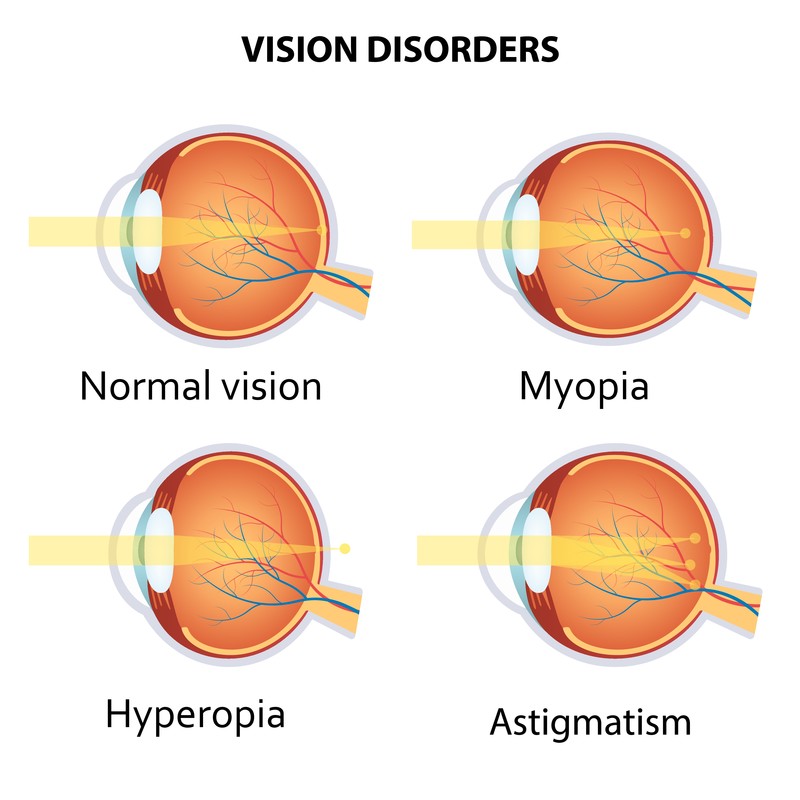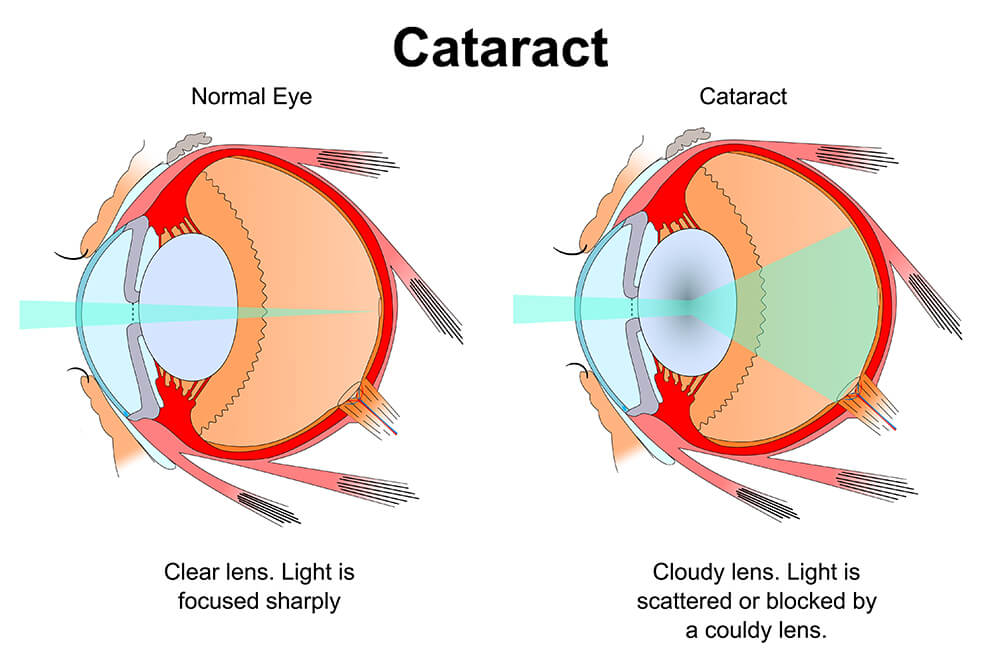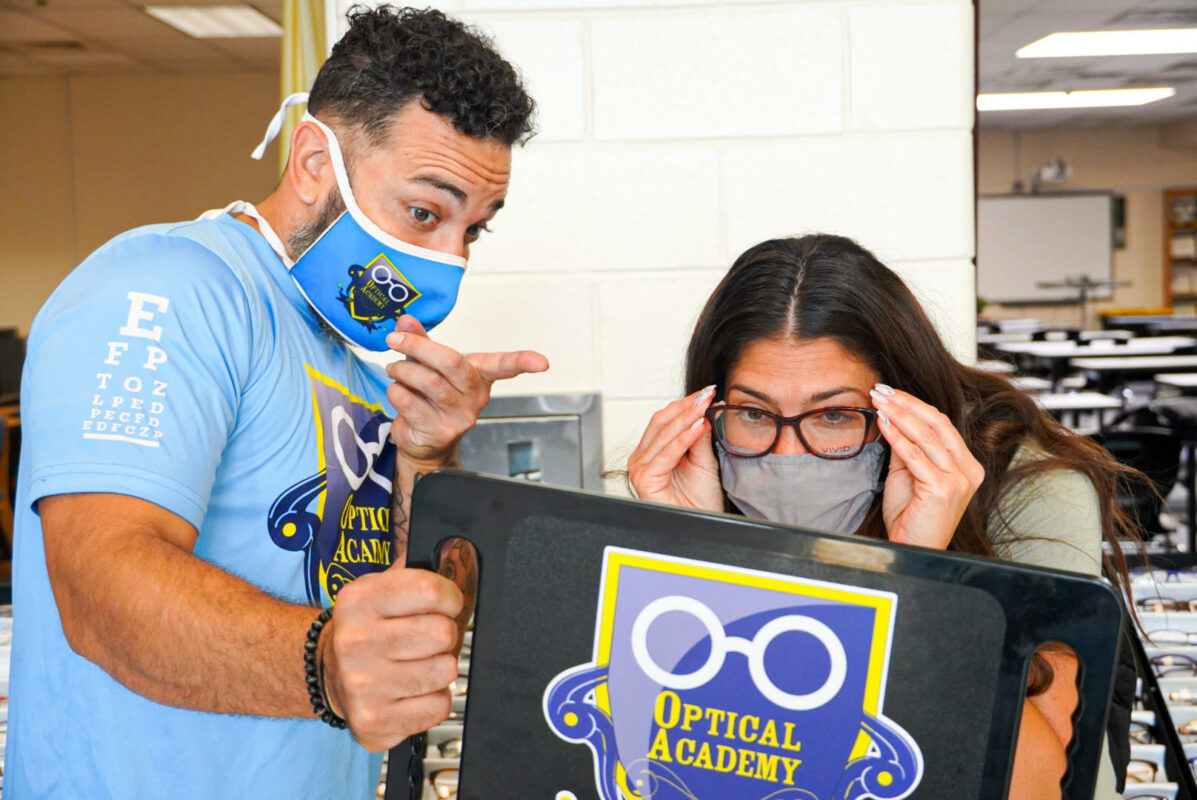While most people think of vision as something that is always perfect. The truth is that many people suffer from common vision problems. These problems can range from mild to severe and can impact a person’s ability to see clearly. The loss of vision is a very common problem in America. Out of every three adults, one has some degree of vision loss.
Help and make sure your eyes are healthy with regular eye exams. It’s important to get your eyes checked for these common vision problems and keep your glasses/contacts prescription up to date.

Refractive Errors
Refractive errors are quite common and affect more than half the world’s population. If you have a refractive error, it means that your eyes are not able to focus on an object. This can lead to visual impairment and so many people with these conditions need glasses or contact lenses for them not to be functionally blind!
Four Most Common Refractive Errors
Myopia (nearsightedness):
Myopia (nearsightedness) is a refractive error in which light rays entering the eye are not bent enough to focus on the retina, causing objects up close to be blurry. Myopia is the most common vision problem, affecting about one-third of the population. It typically develops in childhood and worsens with age.
Hyperopia (farsightedness):
Hyperopia (farsightedness) is a condition in which the eye doesn’t focus images correctly on the retina. This can cause problems with reading, driving, and other activities that require good vision. Hyperopia is caused by an abnormal shape of the eye, an irregular curvature of the lens, or both.
Astigmatism:
Astigmatism is an optical condition that can cause vision problems. It’s sometimes called “warped glasses.” Distortion lines on pictures or apparent blurring around lights sources such as street lamps at night time while driving cars onto dark country roads without any visibility. The main symptom of astigmatism, may not be present in all cases and often goes unnoticed by people until they go for their yearly check-up with the doctor who will take care to inform them about this issue.
Presbyopia:
Presbyopia is a major inconvenience for people who use their eyes on the computer all day long or aging. It makes it difficult to see close-up because you’re looking through an examining instrument’s perspective instead of what life would give us – our own two fields of view! A person with this problem may find themselves squinting or having decreased visual acuity when trying other activities like reading the fine print, while others have no issues whatsoever (in which case they might just need glasses).
How to Prevent Refractive Errors
Refractive errors cannot be prevented, but they can be treated. They can be diagnosed by getting a comprehensive eye exam. It’s recommended by experts to get an eye exam every two years from the age of 18-65. Refractive errors can be treated by having corrective eyeglasses, contact, or refractive surgery.
Diabetic Retinopathy
Diabetic retinopathy is a diabetes complication that affects the eyes. It’s caused by damage to the blood vessels of the light-sensitive tissue at the back of the eye (retina). At first, diabetic retinopathy might cause no symptoms or only mild vision problems.
Over time, diabetic retinopathy can get worse and lead to vision loss. Diabetic retinopathy usually affects both eyes.
Diabetic retinopathy can be classified into four stages:
Mild Nonproliferative retinopathy
Mild Nonproliferative retinopathy is the earliest stage of diabetic retinopathy. In this stage, Microaneurysms (small balloon-like pouches) form in the tiny blood vessels of the retina.
Moderate Nonproliferative retinopathy
Moderate Nonproliferative retinopathy is the next stage of diabetic retinopathy. In this stage, more Microaneurysms form. In addition, blockages occur in the larger blood vessels that nourish the retina.
Severe Nonproliferative retinopathy
Severe Nonproliferative retinopathy is the most advanced stage of diabetic retinopathy before vision loss occurs. In this stage, many more Microaneurysms form. The blockages in the larger blood vessels become more severe. This stage is also characterized by the formation of new, abnormal blood vessels.
Proliferative retinopathy
Proliferative retinopathy is the most advanced stage of diabetic retinopathy. In this stage, new, abnormal blood vessels grow on the retina’s surface. These new blood vessels are very fragile and can leak blood into the clear, jelly-like substance that fills the inside of your eye (vitreous). As more and more blood fills the vitreous, it blocks light from entering your eye, and you begin to lose vision.
How to prevent Diabetic Retinopathy
The best way to prevent vision loss from diabetic retinopathy is to control your blood sugar level and keep your diabetes under control. If you have diabetic retinopathy, regular eye exams are very important to monitor the progression of the disease and to detect any vision changes. If necessary, treatment can be started to help slow the progression of diabetic retinopathy and prevent vision loss.
Treatment for diabetic retinopathy may include:
· Laser surgery (photocoagulation). In laser surgery, a powerful beam of light is used to destroy leaking blood vessels and shrink abnormal new blood vessels.
· Injections of medications into the eye. Medications such as anti-VEGF drugs can be injected into the eye to help stop the growth of abnormal new blood vessels.
· Surgery to remove the vitreous. If bleeding from new, abnormal blood vessels is severe, surgery may be needed to remove the vitreous gel from inside your eye. This surgery is called a vitrectomy.
· Surgery to place a new lens in the eye. If diabetic retinopathy has caused cataracts, surgery may be needed to remove the cloudy lens and replace it with a clear artificial lens.

Cataract
A cataract is a cloudy lens. It can make images look blurry and less colorful. The lens is positioned behind the colored part of your eye (iris). The lens focuses light that passes into your eye, producing clear, sharp images on the retina — the light-sensitive membrane in the eye that functions like the film in a camera.
Most cataracts develop slowly and don’t disturb vision early on. Over time, though, cataracts will eventually interfere with your vision. In fact, cataracts are the main cause of vision loss in people over age 40 and are the principal cause of blindness in the world.
Cataract surgery is very successful in restoring vision, and it’s one of the most commonly performed surgical procedures. More than 3 million people have cataract surgery each year in the United States.
Cataracts usually form slowly and painlessly. Symptoms may include:
* Blurry vision
* Difficulty seeing at night
* Double vision in one eye
* Fading or yellowing of colors
* Increased sensitivity to glare
How to Prevent Cataracts
If you have a cataract, the best thing to do is to see an eye doctor (ophthalmologist) for a thorough exam. He or she can tell you whether surgery is right for you. There’s no way to prevent or slow down the process of having a cataract but there are ways to treat it.
Cataract surgery is usually an outpatient procedure. It involves removing the cloudy lens and replacing it with a clear artificial lens.
Most people who have cataract surgery experience a significant improvement in vision. In fact, more than 90 percent of people who have cataract surgery have much better vision afterward.
Cataract surgery is one of the safest and most successful surgeries performed today. Serious complications from cataract surgery are rare.

Glaucoma
Glaucoma is a group of eye conditions that damage the optic nerve, which may lead to permanent vision loss. This condition occurs when pressure within your eyes becomes too high and damages your health over time; it’s one among several leading causes of blindness in older adults who have had their sight since childhood went away due to this issue alone!
Glaucoma symptoms usually develop gradually and may not be noticeable at first. However, if left untreated, glaucoma can progress and lead to vision loss. There are several types of glaucoma, all of which share the common symptom of increased pressure within the eye. This increase in pressure can damage the optic nerve, which is responsible for sending signals from the eye to the brain.
Types of Glaucoma
Open-angle glaucoma
The most common type of glaucoma, open-angle glaucoma, affects about 3 million Americans. This type of glaucoma generally has no symptoms in its early stages and may go undetected until vision loss occurs.
Angle-closure glaucoma
Another type of glaucoma, angle-closure glaucoma, is much less common but can be more serious. This type of glaucoma occurs when the angle between the iris and the cornea becomes narrower, which prevents proper drainage of fluid from the eye. This can lead to a sudden increase in pressure within the eye, which can cause severe pain, headaches, and nausea. If left untreated, angle-closure glaucoma can lead to permanent vision loss.
How to Prevent Glaucoma
Glaucoma can be treated with eye drops, pills, laser surgery, or traditional surgery. Early diagnosis and treatment are important to prevent vision loss. If you are at risk for glaucoma, be sure to have regular eye exams so that the condition can be detected early and treated.

Protect Your Vision With Optical Academy
In Conclusion, here are the most common vision problems. It’s important to have regular eye exams to keep your eyes healthy and protect your vision. We offer eye in-office and onsite mobile eye exams. Where we bring eye care to you and your community.


Worksite
All Employees Served With Direct Vision Care All In One Day At Their Worksite!.
Glasses2Classes
Vision screenings, eye exams, and eyewear for all students at their schools!
Community Events
Provide Easy Access To Eye Care & Eyewear for Your Entire Community!
At Home
Skip the trip! We travel directly to all fragile homebound patients!